4PS203: Talent Development Program - Job Satisfaction and Motivation
VerifiedAdded on 2022/08/26
|6
|1142
|21
Report
AI Summary
This report provides a critical analysis of job satisfaction and motivation within a global company facing administrative challenges. It explores the application of Maslow's and Herzberg's theories to understand employee needs and identify factors contributing to dissatisfaction and lack of motivation. The report investigates how these theories can be applied to improve employee engagement and work culture. The report suggests solutions for the company to encourage employees to reach their full potential. The report also includes a questionnaire designed to assess the company's current work environment and employee satisfaction levels. The findings of the questionnaire can be used to provide recommendations to the company to improve employee motivation and engagement.
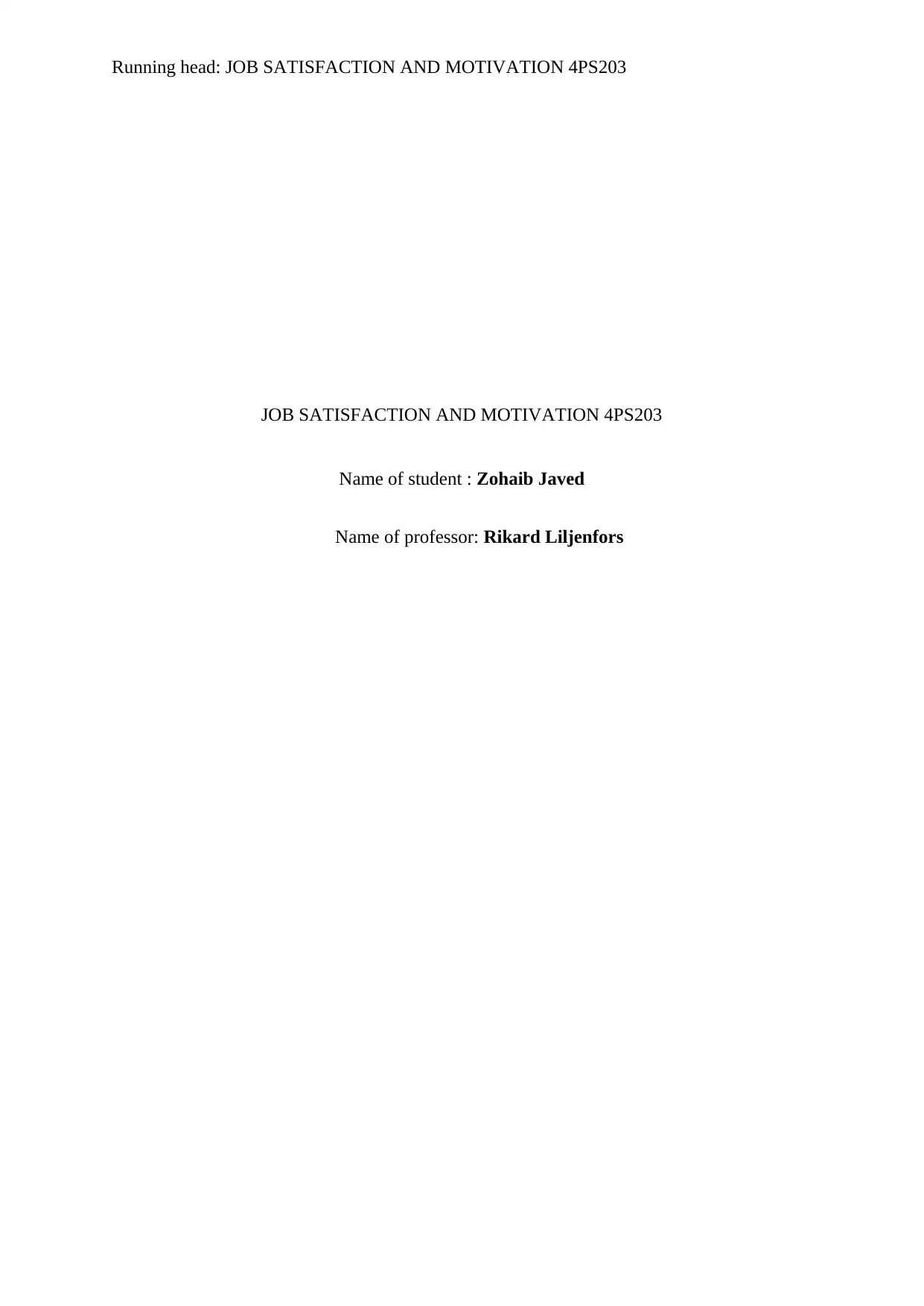
Running head: JOB SATISFACTION AND MOTIVATION 4PS203
JOB SATISFACTION AND MOTIVATION 4PS203
Name of student : Zohaib Javed
Name of professor: Rikard Liljenfors
JOB SATISFACTION AND MOTIVATION 4PS203
Name of student : Zohaib Javed
Name of professor: Rikard Liljenfors
Paraphrase This Document
Need a fresh take? Get an instant paraphrase of this document with our AI Paraphraser
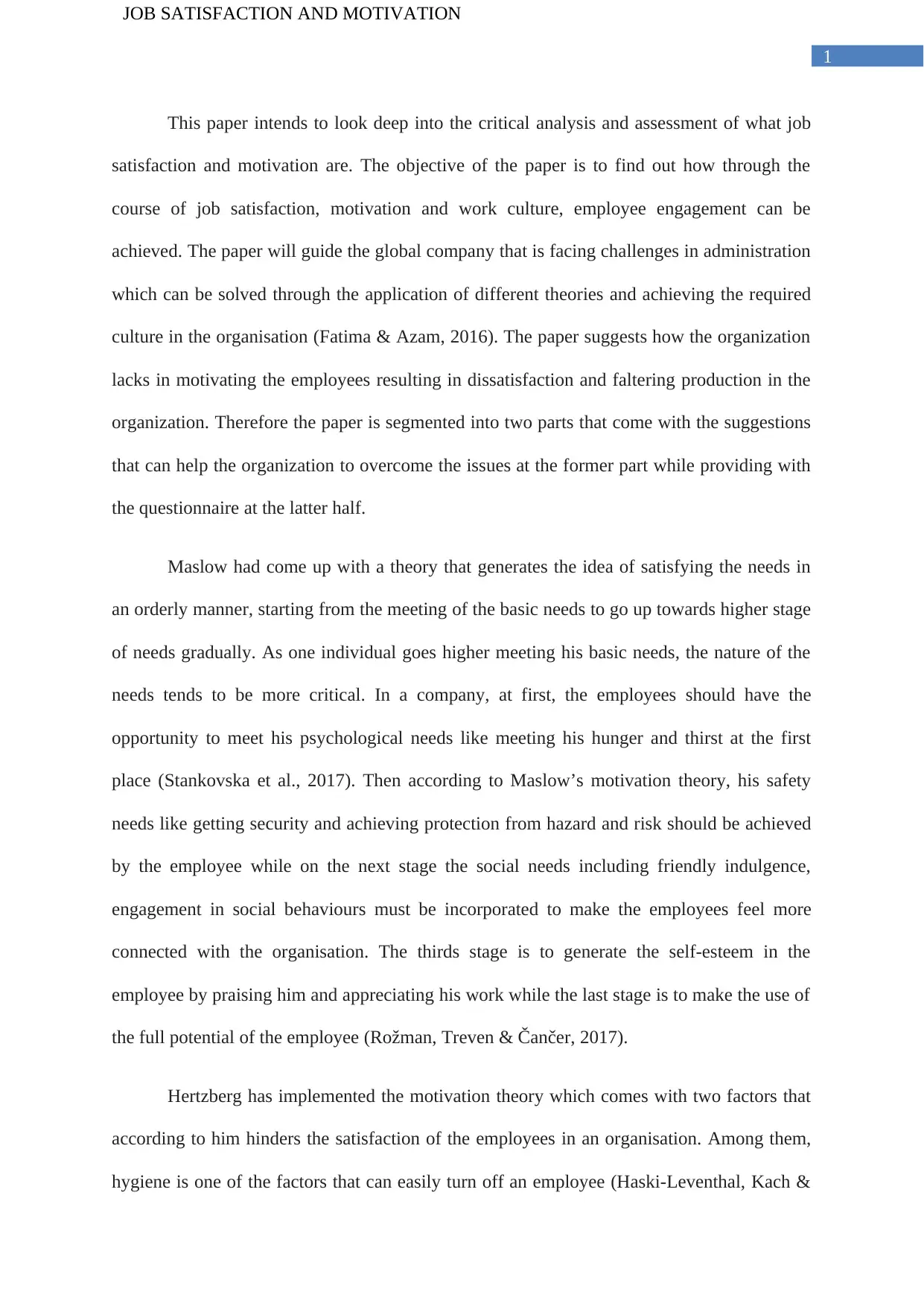
1
JOB SATISFACTION AND MOTIVATION
This paper intends to look deep into the critical analysis and assessment of what job
satisfaction and motivation are. The objective of the paper is to find out how through the
course of job satisfaction, motivation and work culture, employee engagement can be
achieved. The paper will guide the global company that is facing challenges in administration
which can be solved through the application of different theories and achieving the required
culture in the organisation (Fatima & Azam, 2016). The paper suggests how the organization
lacks in motivating the employees resulting in dissatisfaction and faltering production in the
organization. Therefore the paper is segmented into two parts that come with the suggestions
that can help the organization to overcome the issues at the former part while providing with
the questionnaire at the latter half.
Maslow had come up with a theory that generates the idea of satisfying the needs in
an orderly manner, starting from the meeting of the basic needs to go up towards higher stage
of needs gradually. As one individual goes higher meeting his basic needs, the nature of the
needs tends to be more critical. In a company, at first, the employees should have the
opportunity to meet his psychological needs like meeting his hunger and thirst at the first
place (Stankovska et al., 2017). Then according to Maslow’s motivation theory, his safety
needs like getting security and achieving protection from hazard and risk should be achieved
by the employee while on the next stage the social needs including friendly indulgence,
engagement in social behaviours must be incorporated to make the employees feel more
connected with the organisation. The thirds stage is to generate the self-esteem in the
employee by praising him and appreciating his work while the last stage is to make the use of
the full potential of the employee (Rožman, Treven & Čančer, 2017).
Hertzberg has implemented the motivation theory which comes with two factors that
according to him hinders the satisfaction of the employees in an organisation. Among them,
hygiene is one of the factors that can easily turn off an employee (Haski-Leventhal, Kach &
JOB SATISFACTION AND MOTIVATION
This paper intends to look deep into the critical analysis and assessment of what job
satisfaction and motivation are. The objective of the paper is to find out how through the
course of job satisfaction, motivation and work culture, employee engagement can be
achieved. The paper will guide the global company that is facing challenges in administration
which can be solved through the application of different theories and achieving the required
culture in the organisation (Fatima & Azam, 2016). The paper suggests how the organization
lacks in motivating the employees resulting in dissatisfaction and faltering production in the
organization. Therefore the paper is segmented into two parts that come with the suggestions
that can help the organization to overcome the issues at the former part while providing with
the questionnaire at the latter half.
Maslow had come up with a theory that generates the idea of satisfying the needs in
an orderly manner, starting from the meeting of the basic needs to go up towards higher stage
of needs gradually. As one individual goes higher meeting his basic needs, the nature of the
needs tends to be more critical. In a company, at first, the employees should have the
opportunity to meet his psychological needs like meeting his hunger and thirst at the first
place (Stankovska et al., 2017). Then according to Maslow’s motivation theory, his safety
needs like getting security and achieving protection from hazard and risk should be achieved
by the employee while on the next stage the social needs including friendly indulgence,
engagement in social behaviours must be incorporated to make the employees feel more
connected with the organisation. The thirds stage is to generate the self-esteem in the
employee by praising him and appreciating his work while the last stage is to make the use of
the full potential of the employee (Rožman, Treven & Čančer, 2017).
Hertzberg has implemented the motivation theory which comes with two factors that
according to him hinders the satisfaction of the employees in an organisation. Among them,
hygiene is one of the factors that can easily turn off an employee (Haski-Leventhal, Kach &
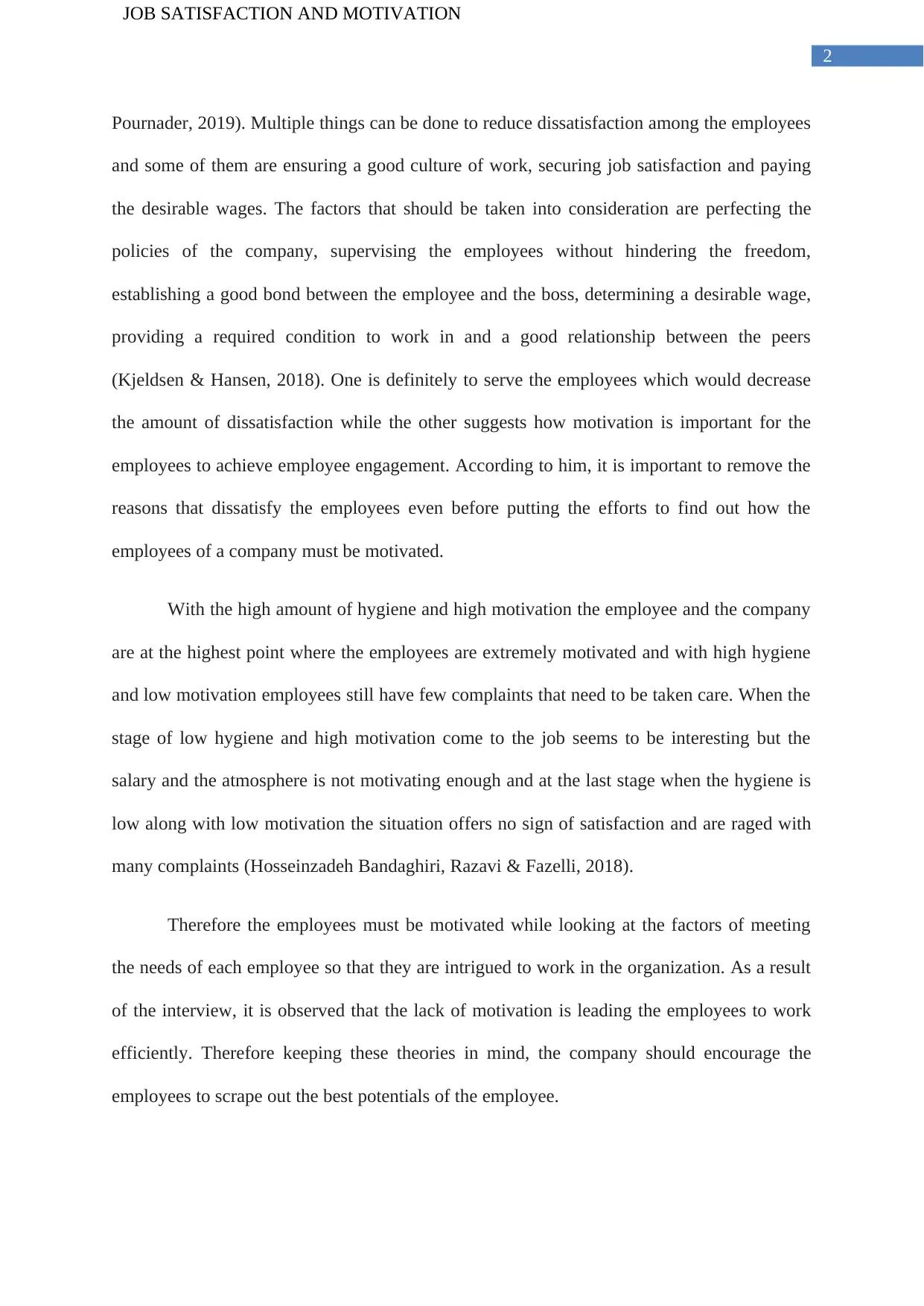
2
JOB SATISFACTION AND MOTIVATION
Pournader, 2019). Multiple things can be done to reduce dissatisfaction among the employees
and some of them are ensuring a good culture of work, securing job satisfaction and paying
the desirable wages. The factors that should be taken into consideration are perfecting the
policies of the company, supervising the employees without hindering the freedom,
establishing a good bond between the employee and the boss, determining a desirable wage,
providing a required condition to work in and a good relationship between the peers
(Kjeldsen & Hansen, 2018). One is definitely to serve the employees which would decrease
the amount of dissatisfaction while the other suggests how motivation is important for the
employees to achieve employee engagement. According to him, it is important to remove the
reasons that dissatisfy the employees even before putting the efforts to find out how the
employees of a company must be motivated.
With the high amount of hygiene and high motivation the employee and the company
are at the highest point where the employees are extremely motivated and with high hygiene
and low motivation employees still have few complaints that need to be taken care. When the
stage of low hygiene and high motivation come to the job seems to be interesting but the
salary and the atmosphere is not motivating enough and at the last stage when the hygiene is
low along with low motivation the situation offers no sign of satisfaction and are raged with
many complaints (Hosseinzadeh Bandaghiri, Razavi & Fazelli, 2018).
Therefore the employees must be motivated while looking at the factors of meeting
the needs of each employee so that they are intrigued to work in the organization. As a result
of the interview, it is observed that the lack of motivation is leading the employees to work
efficiently. Therefore keeping these theories in mind, the company should encourage the
employees to scrape out the best potentials of the employee.
JOB SATISFACTION AND MOTIVATION
Pournader, 2019). Multiple things can be done to reduce dissatisfaction among the employees
and some of them are ensuring a good culture of work, securing job satisfaction and paying
the desirable wages. The factors that should be taken into consideration are perfecting the
policies of the company, supervising the employees without hindering the freedom,
establishing a good bond between the employee and the boss, determining a desirable wage,
providing a required condition to work in and a good relationship between the peers
(Kjeldsen & Hansen, 2018). One is definitely to serve the employees which would decrease
the amount of dissatisfaction while the other suggests how motivation is important for the
employees to achieve employee engagement. According to him, it is important to remove the
reasons that dissatisfy the employees even before putting the efforts to find out how the
employees of a company must be motivated.
With the high amount of hygiene and high motivation the employee and the company
are at the highest point where the employees are extremely motivated and with high hygiene
and low motivation employees still have few complaints that need to be taken care. When the
stage of low hygiene and high motivation come to the job seems to be interesting but the
salary and the atmosphere is not motivating enough and at the last stage when the hygiene is
low along with low motivation the situation offers no sign of satisfaction and are raged with
many complaints (Hosseinzadeh Bandaghiri, Razavi & Fazelli, 2018).
Therefore the employees must be motivated while looking at the factors of meeting
the needs of each employee so that they are intrigued to work in the organization. As a result
of the interview, it is observed that the lack of motivation is leading the employees to work
efficiently. Therefore keeping these theories in mind, the company should encourage the
employees to scrape out the best potentials of the employee.
⊘ This is a preview!⊘
Do you want full access?
Subscribe today to unlock all pages.

Trusted by 1+ million students worldwide
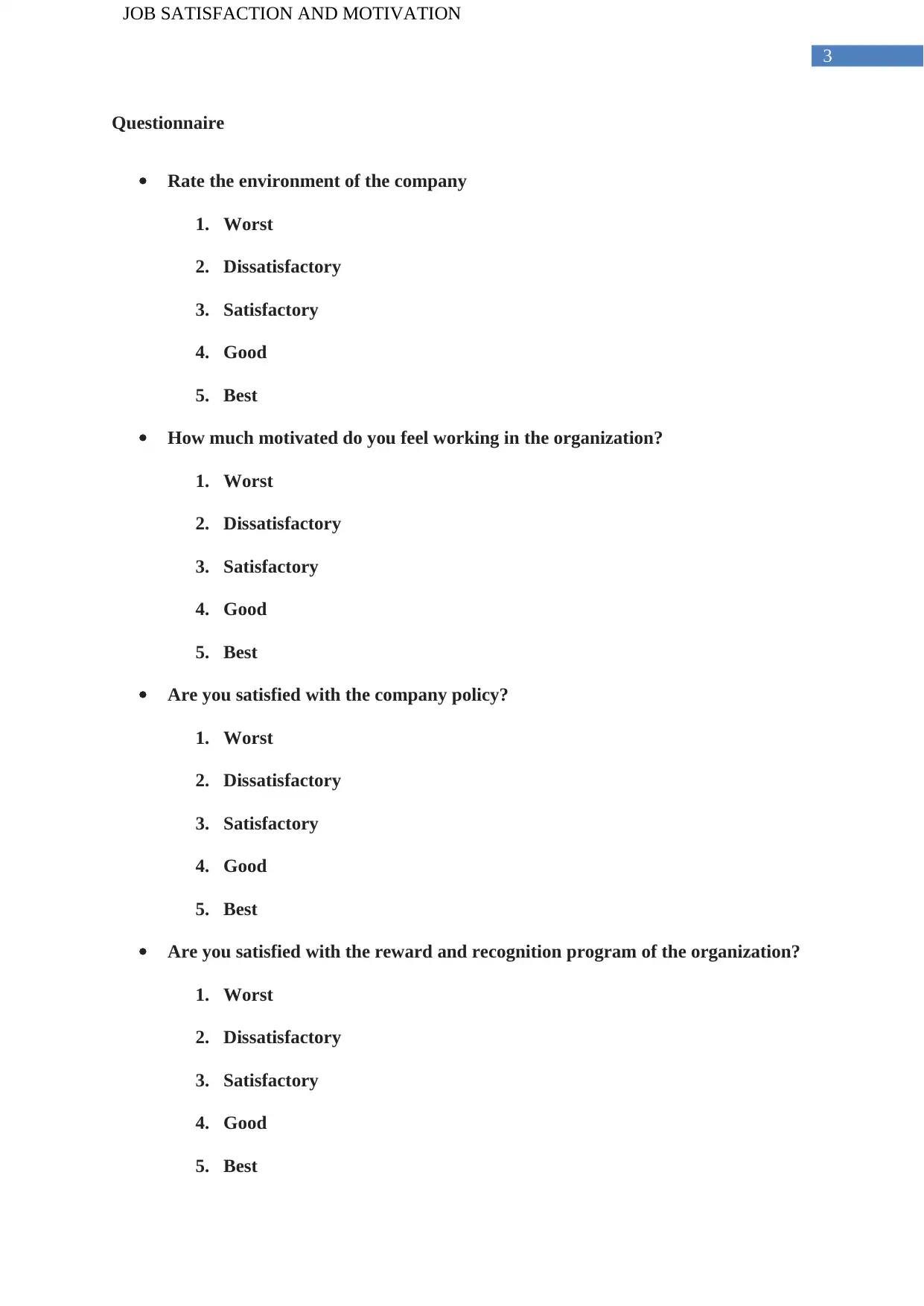
3
JOB SATISFACTION AND MOTIVATION
Questionnaire
Rate the environment of the company
1. Worst
2. Dissatisfactory
3. Satisfactory
4. Good
5. Best
How much motivated do you feel working in the organization?
1. Worst
2. Dissatisfactory
3. Satisfactory
4. Good
5. Best
Are you satisfied with the company policy?
1. Worst
2. Dissatisfactory
3. Satisfactory
4. Good
5. Best
Are you satisfied with the reward and recognition program of the organization?
1. Worst
2. Dissatisfactory
3. Satisfactory
4. Good
5. Best
JOB SATISFACTION AND MOTIVATION
Questionnaire
Rate the environment of the company
1. Worst
2. Dissatisfactory
3. Satisfactory
4. Good
5. Best
How much motivated do you feel working in the organization?
1. Worst
2. Dissatisfactory
3. Satisfactory
4. Good
5. Best
Are you satisfied with the company policy?
1. Worst
2. Dissatisfactory
3. Satisfactory
4. Good
5. Best
Are you satisfied with the reward and recognition program of the organization?
1. Worst
2. Dissatisfactory
3. Satisfactory
4. Good
5. Best
Paraphrase This Document
Need a fresh take? Get an instant paraphrase of this document with our AI Paraphraser
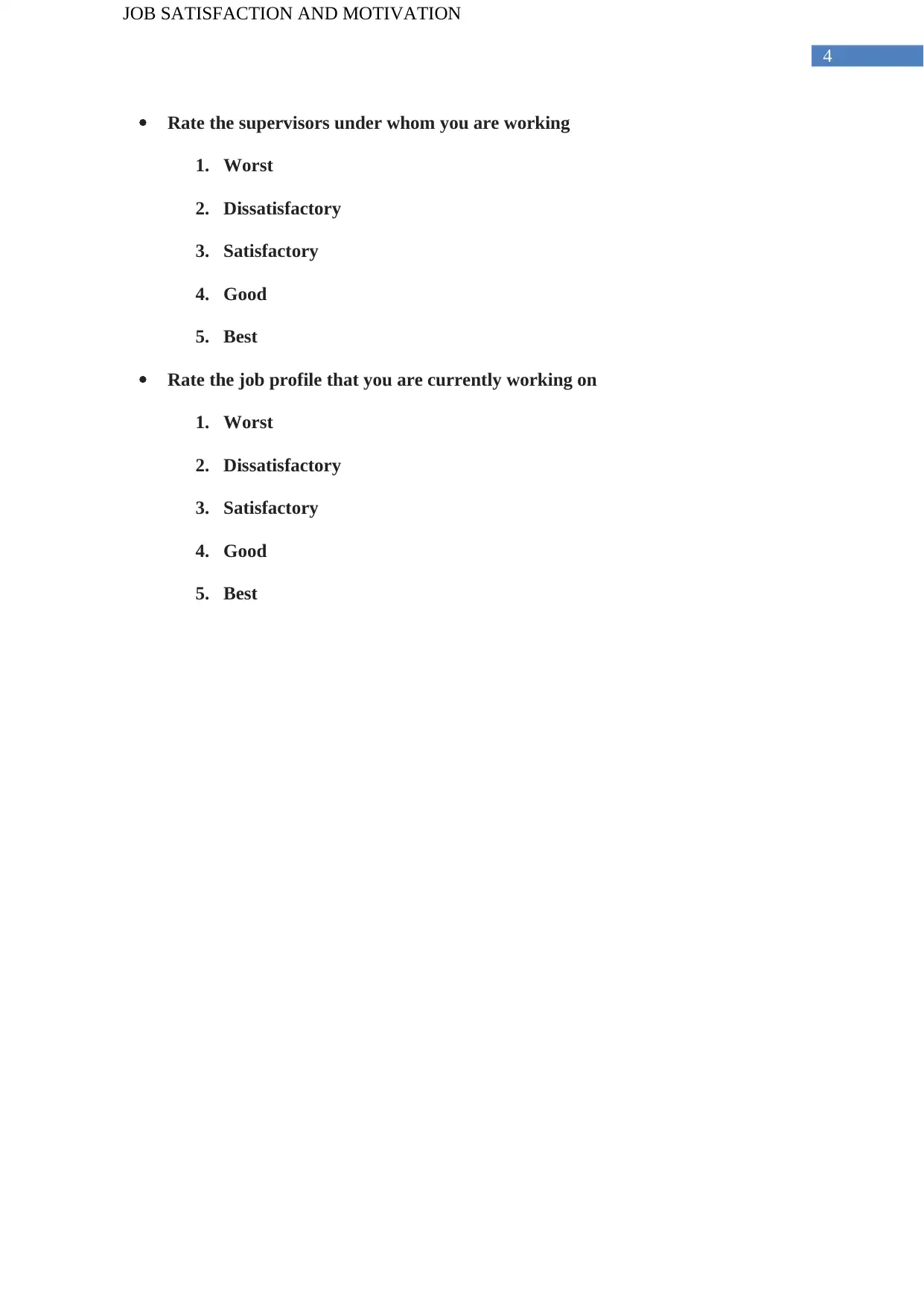
4
JOB SATISFACTION AND MOTIVATION
Rate the supervisors under whom you are working
1. Worst
2. Dissatisfactory
3. Satisfactory
4. Good
5. Best
Rate the job profile that you are currently working on
1. Worst
2. Dissatisfactory
3. Satisfactory
4. Good
5. Best
JOB SATISFACTION AND MOTIVATION
Rate the supervisors under whom you are working
1. Worst
2. Dissatisfactory
3. Satisfactory
4. Good
5. Best
Rate the job profile that you are currently working on
1. Worst
2. Dissatisfactory
3. Satisfactory
4. Good
5. Best
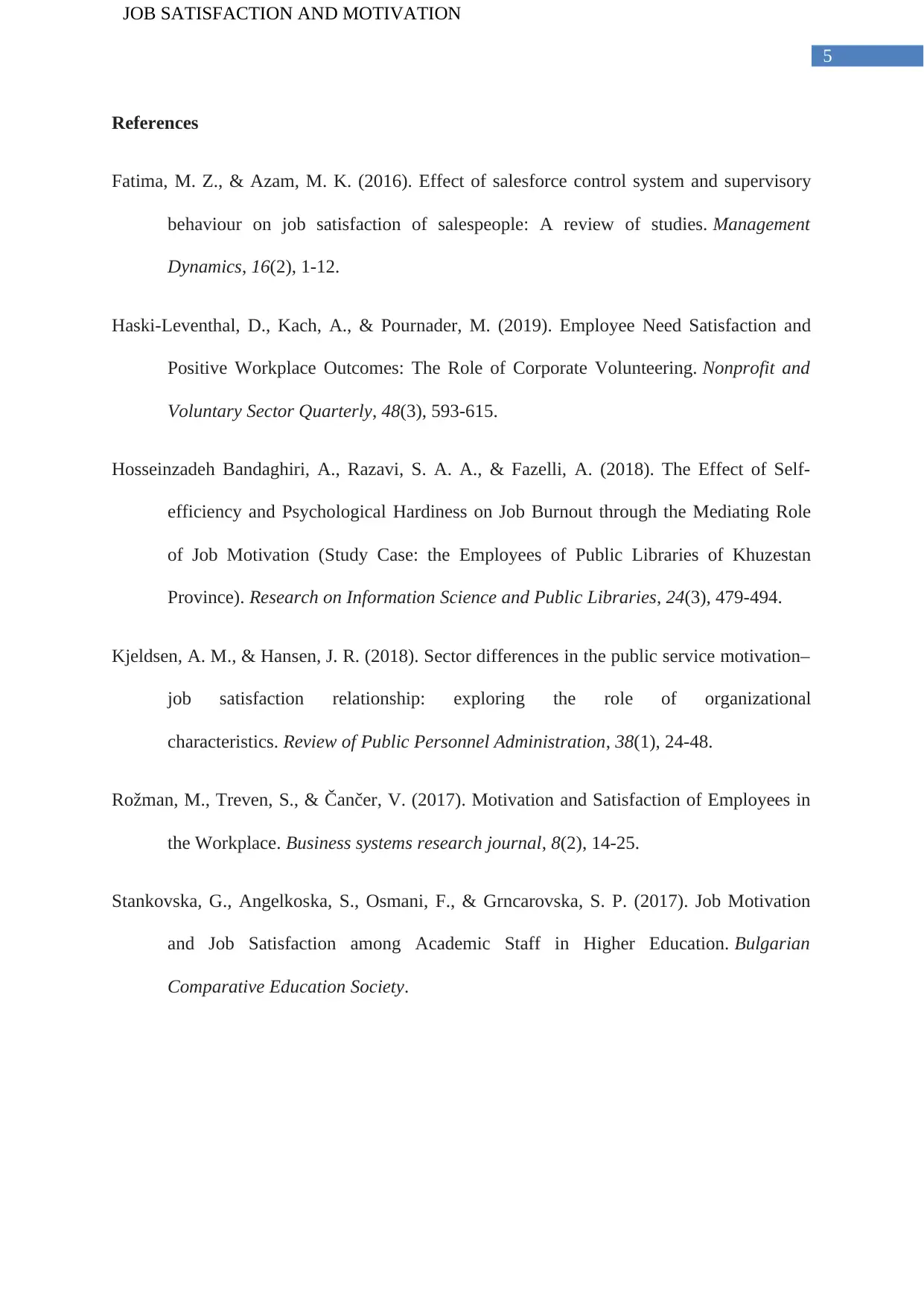
5
JOB SATISFACTION AND MOTIVATION
References
Fatima, M. Z., & Azam, M. K. (2016). Effect of salesforce control system and supervisory
behaviour on job satisfaction of salespeople: A review of studies. Management
Dynamics, 16(2), 1-12.
Haski-Leventhal, D., Kach, A., & Pournader, M. (2019). Employee Need Satisfaction and
Positive Workplace Outcomes: The Role of Corporate Volunteering. Nonprofit and
Voluntary Sector Quarterly, 48(3), 593-615.
Hosseinzadeh Bandaghiri, A., Razavi, S. A. A., & Fazelli, A. (2018). The Effect of Self-
efficiency and Psychological Hardiness on Job Burnout through the Mediating Role
of Job Motivation (Study Case: the Employees of Public Libraries of Khuzestan
Province). Research on Information Science and Public Libraries, 24(3), 479-494.
Kjeldsen, A. M., & Hansen, J. R. (2018). Sector differences in the public service motivation–
job satisfaction relationship: exploring the role of organizational
characteristics. Review of Public Personnel Administration, 38(1), 24-48.
Rožman, M., Treven, S., & Čančer, V. (2017). Motivation and Satisfaction of Employees in
the Workplace. Business systems research journal, 8(2), 14-25.
Stankovska, G., Angelkoska, S., Osmani, F., & Grncarovska, S. P. (2017). Job Motivation
and Job Satisfaction among Academic Staff in Higher Education. Bulgarian
Comparative Education Society.
JOB SATISFACTION AND MOTIVATION
References
Fatima, M. Z., & Azam, M. K. (2016). Effect of salesforce control system and supervisory
behaviour on job satisfaction of salespeople: A review of studies. Management
Dynamics, 16(2), 1-12.
Haski-Leventhal, D., Kach, A., & Pournader, M. (2019). Employee Need Satisfaction and
Positive Workplace Outcomes: The Role of Corporate Volunteering. Nonprofit and
Voluntary Sector Quarterly, 48(3), 593-615.
Hosseinzadeh Bandaghiri, A., Razavi, S. A. A., & Fazelli, A. (2018). The Effect of Self-
efficiency and Psychological Hardiness on Job Burnout through the Mediating Role
of Job Motivation (Study Case: the Employees of Public Libraries of Khuzestan
Province). Research on Information Science and Public Libraries, 24(3), 479-494.
Kjeldsen, A. M., & Hansen, J. R. (2018). Sector differences in the public service motivation–
job satisfaction relationship: exploring the role of organizational
characteristics. Review of Public Personnel Administration, 38(1), 24-48.
Rožman, M., Treven, S., & Čančer, V. (2017). Motivation and Satisfaction of Employees in
the Workplace. Business systems research journal, 8(2), 14-25.
Stankovska, G., Angelkoska, S., Osmani, F., & Grncarovska, S. P. (2017). Job Motivation
and Job Satisfaction among Academic Staff in Higher Education. Bulgarian
Comparative Education Society.
⊘ This is a preview!⊘
Do you want full access?
Subscribe today to unlock all pages.

Trusted by 1+ million students worldwide
1 out of 6
Related Documents
Your All-in-One AI-Powered Toolkit for Academic Success.
+13062052269
info@desklib.com
Available 24*7 on WhatsApp / Email
![[object Object]](/_next/static/media/star-bottom.7253800d.svg)
Unlock your academic potential
Copyright © 2020–2025 A2Z Services. All Rights Reserved. Developed and managed by ZUCOL.





